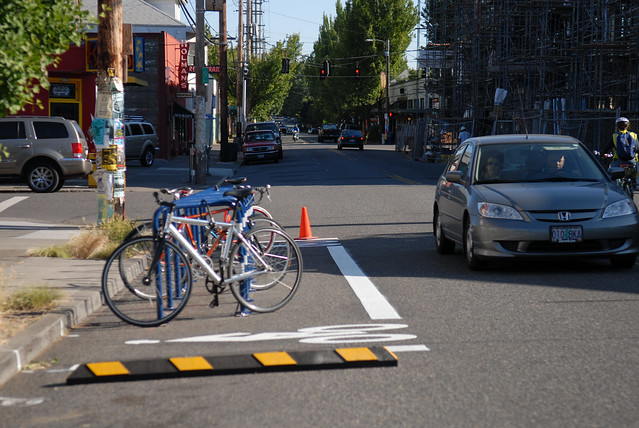
(Photos by J.Maus/BikePortland)
For years, as Portland has looked for ways to calm auto traffic in commercial districts like N Denver Avenue, SE Stark Street or NE 28th Avenue, the biggest tool in its shed — the speed bump — has been off limits.
“PBOT and Fire are in the middle of a conversation about the city’s emergency response network.”
— Diane Dulken, PBOT spokeswoman
The reason: Portland Fire and Rescue says major streets need to be flat and smooth enough for emergency trucks to rush down them, when necessary, without losing critical time when responding to emergencies.
But a new Fire and Rescue policy in the early stages of discussion would soften this rule by designating some major streets as being of secondary importance to emergency response routes. City officials say this might allow speed bumps on some such streets. But it’s not clear whether the decision by the city’s fire chief could be completed in time to affect the design of one street where the option might matter most: 28th Avenue.
“PBOT and Fire are in the middle of a conversation about the city’s emergency response network,” Portland Bureau of Transportation spokeswoman Diane Dulken wrote in an email Thursday. “As for 28th Avenue – it is way too soon to tell if traffic calming would be an option for any portion of that street.”
Rich Newlands, project manager for the ongoing 20s Bikeway project, said Tuesday that he’d seen a map indicating that 28th between NE Sandy and SE Stark might be one of the streets that could be allowed to get speed bumps under a revised fire bureau policy. If the city were in fact able to add speed bumps on 28th and/or 26th, that’d be important because it’s a way to improve the street for biking somewhat without removing auto parking.
“Speed bumps alone… won’t make the route comfortable enough for the interested but concerned.”
— Carl Larson, BTA
A professional biking advocate who’s following the 20s Bikeway project said he didn’t think that adding speed bumps would be enough to make 28th truly welcoming to most Portlanders if they wanted to ride a bicycle there.
“Speed bumps alone (absent extreme woonerf-style traffic calming AND traffic diversion) won’t make the route comfortable enough for the interested but concerned,” Bicycle Transportation Alliance Advocate Carl Larson wrote Thursday. “It’ll only improve things for bolder users. That’s not in keeping with the city’s goals.”
If the city were to install a traffic diverter on 28th, forcing auto traffic to turn east or west at some point, Larson said that might reduce traffic volumes on 28th enough to make most people willing to ride on the street. But he said the city has resisted such a big change.
“I pushed for calming and diversion and was flat-out denied,” Larson said. “PBOT does not seem interested in changing the road’s functional designation.”
The city’s current plan for 28th, as well as for other two commercial districts along the 20s Bikeway, is a so-called “couplet” that would include buffered bike lanes in one direction along the corridor, green-backed sharrow markings in the other, and a nearby parallel neighborhood greenway for bikers who prefer not to use the shared lane.

But the need to remove parking from 28th to make way for the buffered bike lane has some businesses and landlords worried that it’d make the district less convenient to visit, and some nearby residents worried that commercial parking would fill up neighborhood streets.
Even some bicycling advocates say traffic calming might actually be preferable to a one-direction bike lane. Kirk Paulsen, a professional traffic analyst and advocate for better biking who sits on the 20s Bikeway advisory committee, said that the combination of green-backed sharrows, slightly raised crosswalks and speed bumps might be enough to make most Portlanders feel comfortable biking on 28th.
“If all three of those treatments would be used in combination, I honestly believe that the street layout could be left with on-street parking on both sides AND attract a portion of the interested but concerned demographic of bike riders that is highly sought after,” Paulson wrote Thursday. “Personally, I’d be more in favor of that design that keeps the roadway symmetrical (to all users) and focuses most of its attention on calming traffic as opposed to fighting the political battle to remove parking on one side for a design that only works well in one direction. It’d be much easier for all users to know what is expected of them with that very simple but effective design of calming traffic.”
Dulken, the city spokeswoman, downplayed the importance of speed bumps to the city’s decision about the best design for 28th and other commercial districts along the 20s bikeway.
“Even if they would be an option on a portion of 28th, they would be a component in a larger street design and by themselves would not change the overall conversation of whether bike lanes belong on any portion of 28th,” Dulken said.
Larson, meanwhile, welcomed the fire bureau proposal and said it’d be “good news for other projects” if it comes together. Stay tuned — we’ll definitely be covering its progress.


